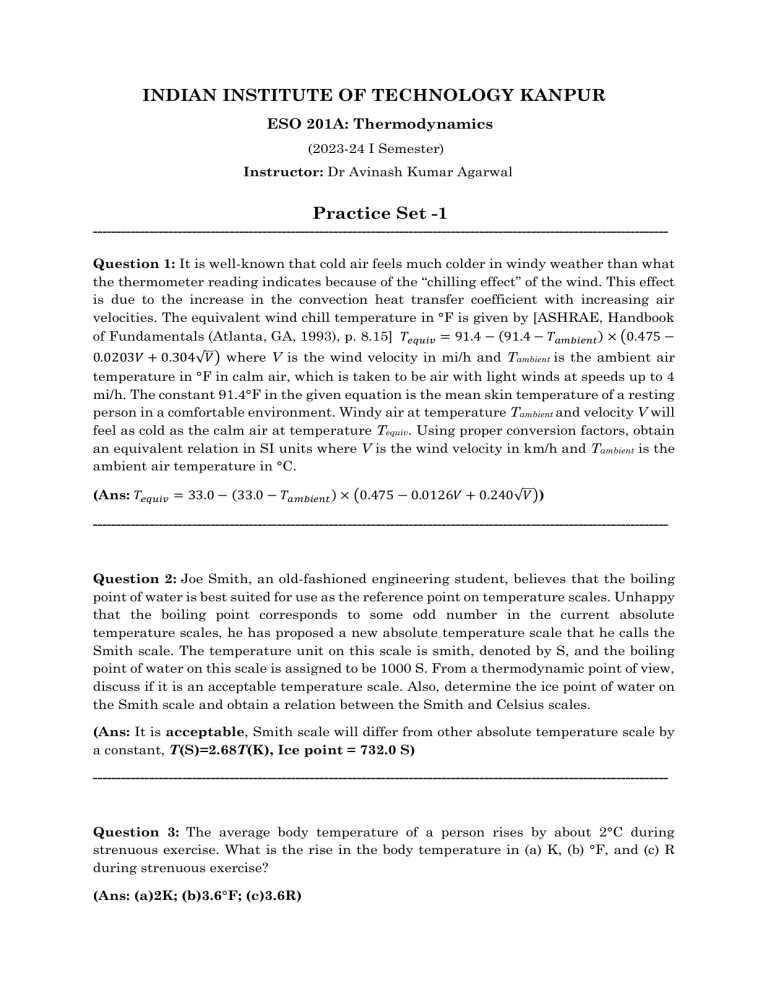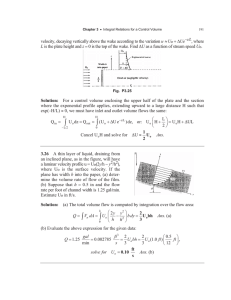
INDIAN INSTITUTE OF TECHNOLOGY KANPUR ESO 201A: Thermodynamics (2023-24 I Semester) Instructor: Dr Avinash Kumar Agarwal Practice Set -1 -------------------------------------------------------------------------------------------------------------------------Question 1: It is well-known that cold air feels much colder in windy weather than what the thermometer reading indicates because of the “chilling effect” of the wind. This effect is due to the increase in the convection heat transfer coefficient with increasing air velocities. The equivalent wind chill temperature in °F is given by [ASHRAE, Handbook of Fundamentals (Atlanta, GA, 1993), p. 8.15] 𝑇𝑒𝑞𝑢𝑖𝑣 = 91.4 − (91.4 − 𝑇𝑎𝑚𝑏𝑖𝑒𝑛𝑡 ) × (0.475 − 0.0203𝑉 + 0.304√𝑉) where V is the wind velocity in mi/h and Tambient is the ambient air temperature in °F in calm air, which is taken to be air with light winds at speeds up to 4 mi/h. The constant 91.4°F in the given equation is the mean skin temperature of a resting person in a comfortable environment. Windy air at temperature Tambient and velocity V will feel as cold as the calm air at temperature Tequiv. Using proper conversion factors, obtain an equivalent relation in SI units where V is the wind velocity in km/h and Tambient is the ambient air temperature in °C. (Ans: 𝑇𝑒𝑞𝑢𝑖𝑣 = 33.0 − (33.0 − 𝑇𝑎𝑚𝑏𝑖𝑒𝑛𝑡 ) × (0.475 − 0.0126𝑉 + 0.240√𝑉)) -------------------------------------------------------------------------------------------------------------------------- Question 2: Joe Smith, an old-fashioned engineering student, believes that the boiling point of water is best suited for use as the reference point on temperature scales. Unhappy that the boiling point corresponds to some odd number in the current absolute temperature scales, he has proposed a new absolute temperature scale that he calls the Smith scale. The temperature unit on this scale is smith, denoted by S, and the boiling point of water on this scale is assigned to be 1000 S. From a thermodynamic point of view, discuss if it is an acceptable temperature scale. Also, determine the ice point of water on the Smith scale and obtain a relation between the Smith and Celsius scales. (Ans: It is acceptable, Smith scale will differ from other absolute temperature scale by a constant, T(S)=2.68T(K), Ice point = 732.0 S) -------------------------------------------------------------------------------------------------------------------------- Question 3: The average body temperature of a person rises by about 2°C during strenuous exercise. What is the rise in the body temperature in (a) K, (b) °F, and (c) R during strenuous exercise? (Ans: (a)2K; (b)3.6°F; (c)3.6R) -------------------------------------------------------------------------------------------------------------------------- Question 4: Consider the flow of air through a wind turbine whose blades sweep an area of diameter D (in m). The average air velocity through the swept area is V (in m/s). On the bases of the units of the quantities involved, show that the mass flow rate of air (in kg/s) through the swept area is proportional to air density, the wind velocity, and the square of the diameter of the swept area. (Use concept of dimensional homogeneity) -------------------------------------------------------------------------------------------------------------------------- Question 5: The weight of bodies may change somewhat from one location to another as a result of the variation of the gravitational acceleration g with elevation. Accounting for this variation using the relation g = a – bz where a = 9.807 m/s2 and 𝑏 = 3.32 × 10−6 𝑠 −2 , determine the weight of an 80-kg person at sea level (z = 0), in Denver (z = 1610 m), and on the top of Mount Everest (z = 8848 m). (Ans: 784.6N, 784.2N and 782.2 N respectively) -------------------------------------------------------------------------------------------------------------------------- Question 6: Hyperthermia of 5°C (i.e., 5°C rise above the normal body temperature) is considered fatal. Express this fatal level of hyperthermia in (a) K, (b) °F, and (c) R. (Ans: (a)5K; (b)9°F; (c)9R) -------------------------------------------------------------------------------------------------------------------------- Question 7: The drag force exerted on a car by air depends on a dimensionless drag coefficient, the density of air, the car velocity, and the frontal area of the car. That is, FD = function (CDrag , Afront, ρ, V). Based on unit considerations alone, obtain a relation for the drag force. (Ans: FD = CDrag ρ Afront V2) --------------------------------------------------------------------------------------------------------------------------





